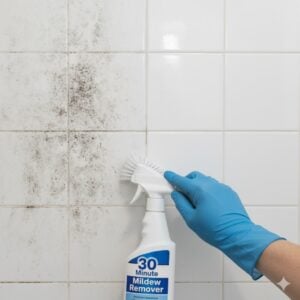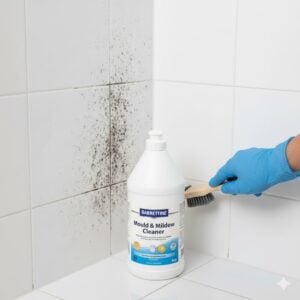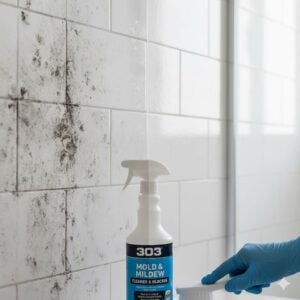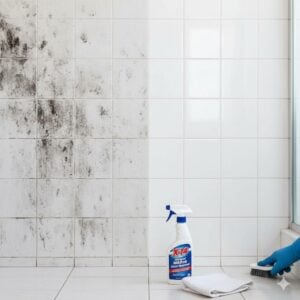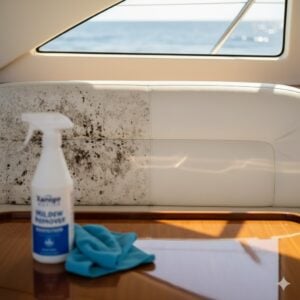In the UAE, where the air conditioning runs almost every day of the year, your AC is a lifeline. But what if the cool air coming out isn’t as clean as it seems? Many residents are surprised to learn that mold in AC units is a common problem—and it often goes unnoticed until the smell, allergies, or breathing problems kick in.
This kind of mold doesn’t just grow on walls or in bathrooms—it thrives inside your cooling system, where moisture and dust build up silently over time. And once it’s there, it can spread spores into the air every time you switch on the unit. In this article, we will show you exactly why mold appears in air conditioners, how to spot the early signs, and what can be done to remove it safely and permanently.
Table of Contents
Toggle1. Why Mold Grows Inside AC Units
Mold needs just three things to grow: moisture, warmth, and organic material (like dust). Unfortunately, AC units provide all three. When your AC runs, the cooling coils create condensation. This moisture collects inside the unit, especially if the filters are dirty or the drainage is blocked. Add a little dust, and you’ve got a perfect environment for mold to take hold.
This is especially true in the UAE, where high humidity and temperature changes mean your AC works overtime. Units in bedrooms and living rooms often have poor airflow, and if not cleaned regularly, they start to trap moisture deep inside the ducts or behind the fins. Central HVAC systems and split units alike can harbor mold—sometimes without any visible sign until it spreads.
To make matters worse, people often leave their ACs off for a few days during travel or cooler months. That’s when mold loves to grow—when the system is dark, damp, and unused. By the time you turn it on again, spores are ready to blow into every room of your home.
2. Signs That Your AC Might Have Mold
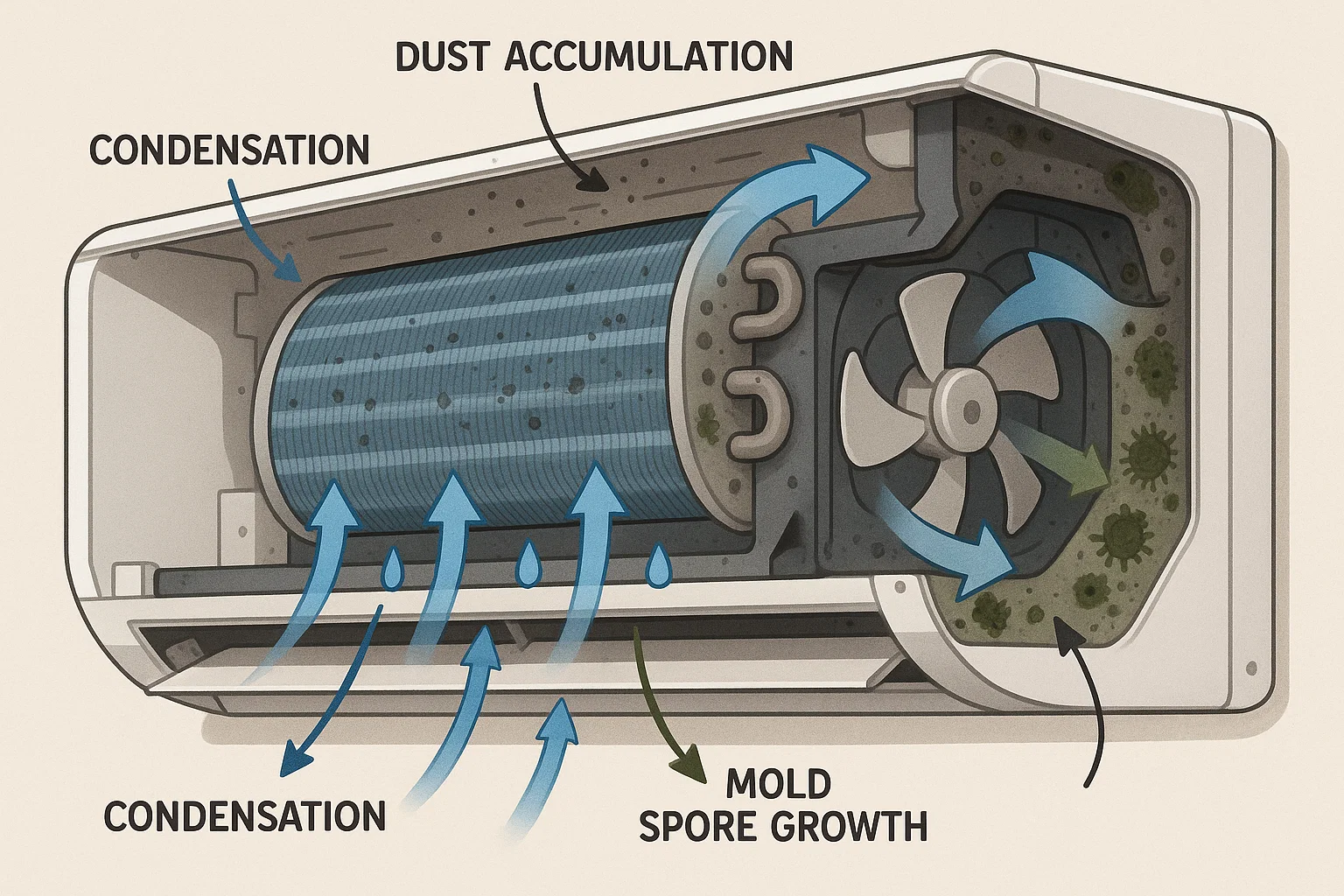
How can you tell if there’s mold in your AC? While some signs are obvious, others are more subtle. Here are a few red flags to watch out for:
- Musty smell: If your room smells earthy or stale when the AC is running, it’s often the first sign of mold growing inside the unit.
- Allergy flare-ups: Sneezing, coughing, or itchy eyes that get worse indoors might be caused by airborne mold spores.
- Black or green spots: Visible mold growth near the vents, filters, or drainage areas is a clear warning sign.
- Weaker airflow or higher energy bills: Mold can block airflow and reduce your AC’s efficiency, making it work harder to cool the room.
Even if you don’t see anything unusual, it doesn’t mean your unit is mold-free. Mold can hide deep inside the coils and ducts where it’s invisible to the naked eye. That’s why regular inspection and cleaning are so important—especially in homes with kids, elderly family members, or people with respiratory conditions.
3. Dangers of Breathing Air from Moldy AC
When mold grows inside your AC, it’s not just your nose that suffers. Mold spores can be pushed into every room each time you turn on the system. Breathing that air regularly may affect your health, especially if you’re sensitive or live with small children, elderly family members, or anyone with asthma or allergies.
Short-term exposure can cause symptoms like sneezing, itchy throat, coughing, or red eyes. But if the problem goes on for weeks or months, it may lead to more serious respiratory issues or trigger chronic conditions. Some people report frequent headaches, sinus infections, or difficulty sleeping without ever realizing the AC is the source of the problem.
Inhaling moldy air also lowers your indoor air quality (IAQ), which matters more than many people think—especially in cities like Dubai or Abu Dhabi, where we rely heavily on sealed, climate-controlled environments. If you want to breathe cleaner, safer air at home or work, tackling AC mold is essential.
4. How to Clean Mold in Your AC System Properly
If you notice any of the signs above, the first instinct may be to clean the AC yourself. While basic cleaning is helpful—like washing the filter or wiping the vents—it’s usually not enough to remove mold entirely. In fact, opening the unit without the right tools or protective gear can accidentally spread more spores around your space.
A proper mold removal process includes:
- Step 1: Inspection using moisture meters or borescopes to locate hidden mold inside coils or ducts.
- Step 2: HEPA vacuuming and air containment to avoid spreading spores during cleaning.
- Step 3: Application of non-toxic biocide or antifungal solution to eliminate mold inside the AC unit and surrounding vents.
- Step 4: Filter replacement and system drying to stop future moisture buildup.
We at Bio-On UAE use municipality-approved eco-friendly treatments that target mold safely without introducing harmful chemicals into your home. Our technicians are trained to work with split AC units, HVAC systems, and even central ducted systems commonly found in larger villas or commercial spaces.
Cleaning your AC professionally isn’t just a fix—it’s an investment in cleaner air, lower energy bills, and peace of mind.
5. How to Prevent Mold from Returning in Your AC
Once your AC is cleaned and mold-free, keeping it that way is the next step. The good news is—it’s not complicated. With just a few simple habits and regular checkups, you can enjoy cool, clean air all year round.
Clean your filters monthly: Dust and debris are mold’s food source. Wash or replace your AC filters every 30 days—especially during the summer months when usage is high.
Service your AC every 6 months: Scheduling professional servicing twice a year helps spot early signs of mold, moisture buildup, or airflow blockages before they turn into major problems.
Control humidity indoors: In very humid rooms like bathrooms or kitchens, consider using a dehumidifier. Try to keep indoor humidity below 60% if possible.
Let the fan run after switching off: After turning off your AC, run the fan-only mode for 15–20 minutes. This helps dry out residual condensation inside the unit, making it harder for mold to grow.
Keep vents clear and furniture spaced out: Good airflow is key. Avoid blocking AC vents with furniture or curtains. The better the air circulates, the less chance moisture has to settle.
These small adjustments, combined with regular AC maintenance, help ensure that mold doesn’t get a second chance to grow in your cooling system.
Conclusion
AC mold is sneaky. It hides inside your walls, spreads through the air, and affects your health and comfort in ways you may not even notice—until it’s too late. But the good news is, it’s completely manageable when treated the right way.
By understanding how mold grows in AC units, recognizing the early signs, and choosing proper cleaning and prevention methods, you can enjoy fresh, healthy air in every room of your home.
If you suspect mold in your air conditioner—or just want peace of mind—click the contact button on the right-middle of this post. We at Bio-On UAE are here to inspect, clean, and protect your AC system with municipality-approved, eco-safe solutions built for the UAE climate. Let’s make your air safer—starting today.









